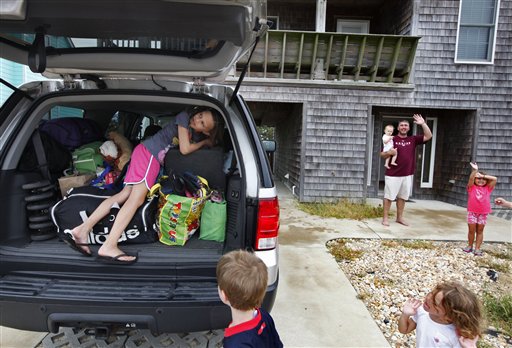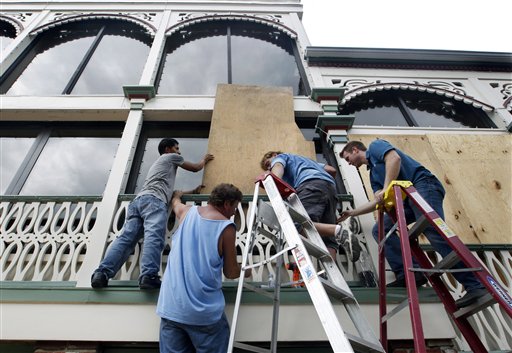 Ella Clark, left, and her family look up and wave at the news helicopters circling Nags Head, N.C. as her family prepares to leave the Outer Banks before Hurricane Irene hits on Friday, Aug. 26, 2011 in Nags Head. The Clarks own the house but live in Virginia and were cutting their vacation a few days short to head back home. With four young children they didn't want to take the risk of staying and then deal with the possibility of no water or power.
Ella Clark, left, and her family look up and wave at the news helicopters circling Nags Head, N.C. as her family prepares to leave the Outer Banks before Hurricane Irene hits on Friday, Aug. 26, 2011 in Nags Head. The Clarks own the house but live in Virginia and were cutting their vacation a few days short to head back home. With four young children they didn't want to take the risk of staying and then deal with the possibility of no water or power.RELATED ARTICLE• Hurricane Irene sways local shipping
NAGS HEAD, N.C. - Kristin Ryce visited two hardware stores Friday on the Outer Banks looking for sand bags. She left empty-handed each time.
So as the persistent winds from Hurricane Irene carved the dunes and roused the ocean behind her, Ryce took an ice scoop to the beach, shoveling sand into plastic bags and loading them into her car. She stacked them in front of the door of her home, a quarter mile from the beach.
"We've got generators, we've got gas, but we just didn't have sand bags," said Ryce, 36. "I'm making my own." A mandatory evacuation order left the northern Outer Banks mostly barren, but a good number of sun-baked, wind-hardened locals like Ryce decided to stay.
Dare County emergency management officials expected gale force winds to cause flooding and knock out power early Friday morning as the hurricane approached this narrow spit of coastline.
"Those who do not evacuate should expect consequences," county officials warned in a 5 p.m. Friday bulletin.
Chris Clark and his family didn't want to take chances. Not with four kids in tow. "The kids would drive us nuts if they couldn't watch TV or play Wii and PlayStation," said Clark, a Northern Virginia mortgage loan officer, as he packed the car.
As they departed about 3 p.m., Clark joked that his crew was "the last family out of Nags Head." ''I was starting to wonder if it was January," he said, scanning the empty beach houses, which are normally decorated with colorful beach towels and boogie boards during the final weekend in August. "It's kind of eerie, like a ghost town." All afternoon on U.S. 64, the main road leading from Nags Head, a column of cars - many with beach chairs and umbrellas strapped to the roof and others pulling boats loaded like Noah's Ark - left the Outer Banks, fighting blinding squalls of rain as the first bands from the expansive storm hit the coast.
In the small towns along the road, locals left store shelves empty of flashlights, water, plastic gas cans and ice. A few gas stations also ran out of regular unleaded.
At the Alligator River Marina, clerk Lorraine Gonzalez fidgeted and kept peering out the window at a television reporter warned about "the storm of a lifetime." Gonzalez, who lives in East Lake west of Manteo, was eager for the store to close so she could hit the road. "I am headed for Greenville, but now they are telling me that's not far enough," she said.
Out on the coast as evening approached, storm gawkers gathered on beach access boardwalks to see hardy surfers catch waves at high tide and watch the growing ocean reclaim the sand.
The town of Nags Head is spending $37 million on a beach renourishment project to protect a number of piers and oceanfront houses. Many residents worried that it would vanish overnight.
"It might be gone tomorrow," said Steve Ryce, Kristin's husband. "But hopefully it might buy us a little extra protection."
